Death Stranding is Hideo Kojima's first big open-world game following his public departure from Konami and the Metal Gear Solid franchise. Ever since its 2016 reveal, it's been shrouded in mystery. In the years following its announcement, Death Stranding has somehow become increasingly stranger and off-kilter with every passing trailer and cryptic messages from the creator about the game. With so many unusual characters and plot threads, even by Kojima's standards, it's been especially challenging to keep up with the game's unique narrative and style. That's begged the question: Just what is Death Stranding? With the game out now and many struggling to explain how the game works and what it's all about, you might be wondering this that much more.
In our review of Death Stranding, we saw first-hand how much there is to do in the open-world game, which puts you in the shoes of courier-turned-American reconstructionist Sam Porter Bridges (played by Norman Reedus). During our time with the game, the overall story that Death Stranding was made all the more clear, and it's surprisingly easy to take in what's driving Sam on his journey through the ruins of North America, that's populated by undead specters and hostile bandits. Throughout the game, we learned what the baby in the capsule is for, and just what the deal is with oddball characters like the masked Die-Hardman. We've now arrived at its November 8 release date--with a PC version to come in Summer 2020--and we figured it was time to share our notes. Here's GameSpot's spoiler-free breakdown of what Death Stranding is all about.
Hands Across America
Set 10 years after an event known as the Death Stranding pulled large segments of the North American population into the afterlife, you play as Sam Porter Bridges, a legendary porter in the remnants of the United Cities of America. Following the event, a new material known as Chiralium has spread across the world, crippling the remains of civilization, its vast infrastructure, and forcing survivors into underground bunkers. As a result of the Death Stranding, a supernatural rain known as Timefall regularly coats the land, which instantly ages anyone and anything exposed to it. With so many new dangers out in the quiet, post-apocalyptic landscape, not many people are willing to venture out into the outside world.
Recruited by the President of the United Cities of America, Bridget Strand, Sam works with the organization BRIDGES to help rebuild the nation and discover what happened to a previous expedition that sought to restore the country. To do that, he'll deliver cargo across the fractured remains of civilization and re-establish various Strands, a line of communication connecting survivors and different waystations across the nation. These various Strands will bolster the Chiral Network, allowing more people to stay connected and leave their fear-induced isolation. During his expedition, Sam will contend with supernatural entities and insurgent forces that now inhabit the land. In the aftermath of the Death Stranding event, the line between life and death has blurred, allowing creatures and individuals once thought dead to cross over into the real world--and the other way around.
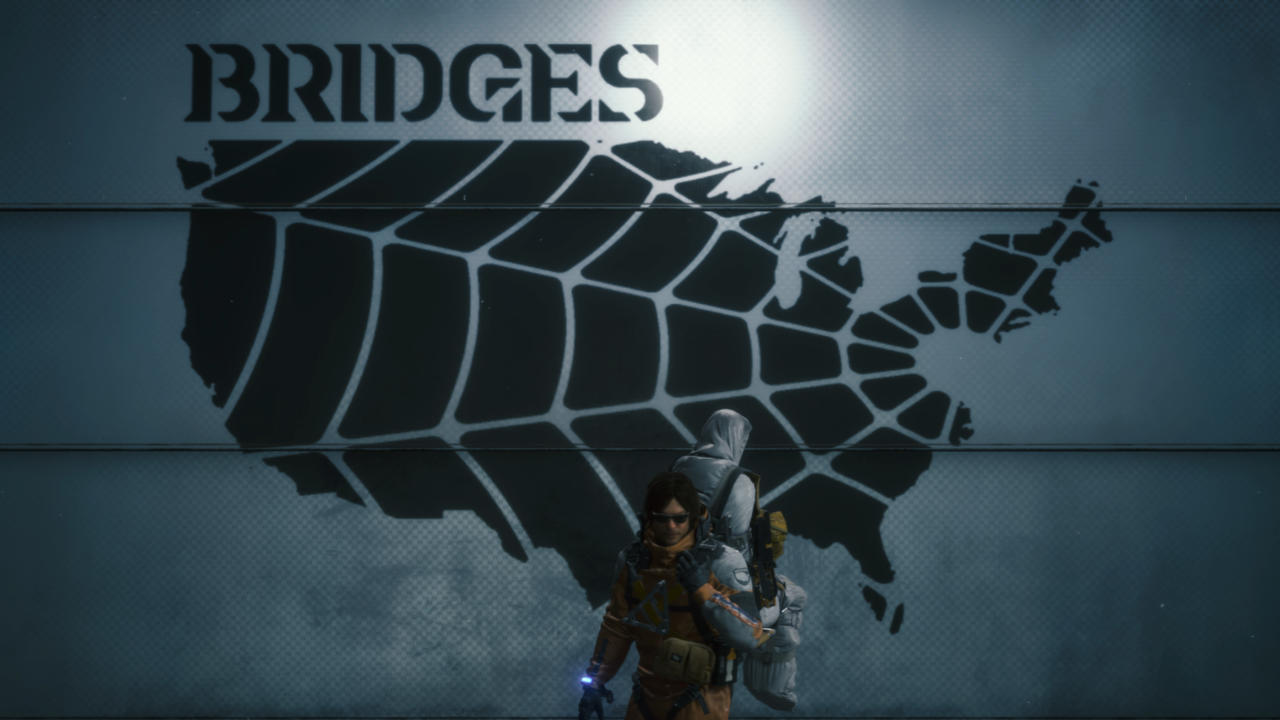
The game's title is a reference to the phenomena where aquatic animals--such as whales and dolphins--wash along shores en masse. During this bizarre event that once only affected cetacean animals, the sea creatures die a slow death in places that are foreign to them. The game's narrative evolves the concept, presenting a scenario where large portions of the human population are swept away and brought into the realm of the dead. All the while, supernatural entities start to roam about, corrupting isolated areas of the country to take the remaining humans back to the realm of the dead. Humans who are caught by BTs are violently dragged away, leading to an occurrence known as a 'voidout.' When a voidout is triggered, an explosion will transpire, leaving a massive crater on the land.
"I make deliveries. That's all" -- Sam Porter Bridges
This strange approach to narrative and the setting is not only a way to justify how Sam re-engages with a fractured world, but it also serves as the framework for Death Stranding's exploration and social gameplay. By establishing more bonds with civilians and the isolated cities, you will be able to progress further into the world and advance Sam's capabilities in ways that weren't possible with fewer connections. If he ventures too far outside of the existing network's reach, you'll get disconnected from benefits it can offer--which include map data, safe houses, and resources from other porters.
According to a post from Hideo Kojima on social media, Death Stranding focuses on the act of bridging the divide with characters and other players online. All taking place in a world where isolation is commonplace, and where the bizarre is the new normal.
"People have built 'Walls' and become accustomed to living in isolation. Death Stranding is a completely new type of action game, where the player's goal is to reconnect isolated cities and a fragmented society. All elements including the story and gameplay, are bound together by the theme of 'Strand', or a connection.
As Sam Porter Bridges, you will attempt to 'Bridge' these divisions, and in doing so, create new bonds or 'Strands' with other players around the globe. Through your experience of playing the game, I hope you'll come to understand the importance of forging connections with others."
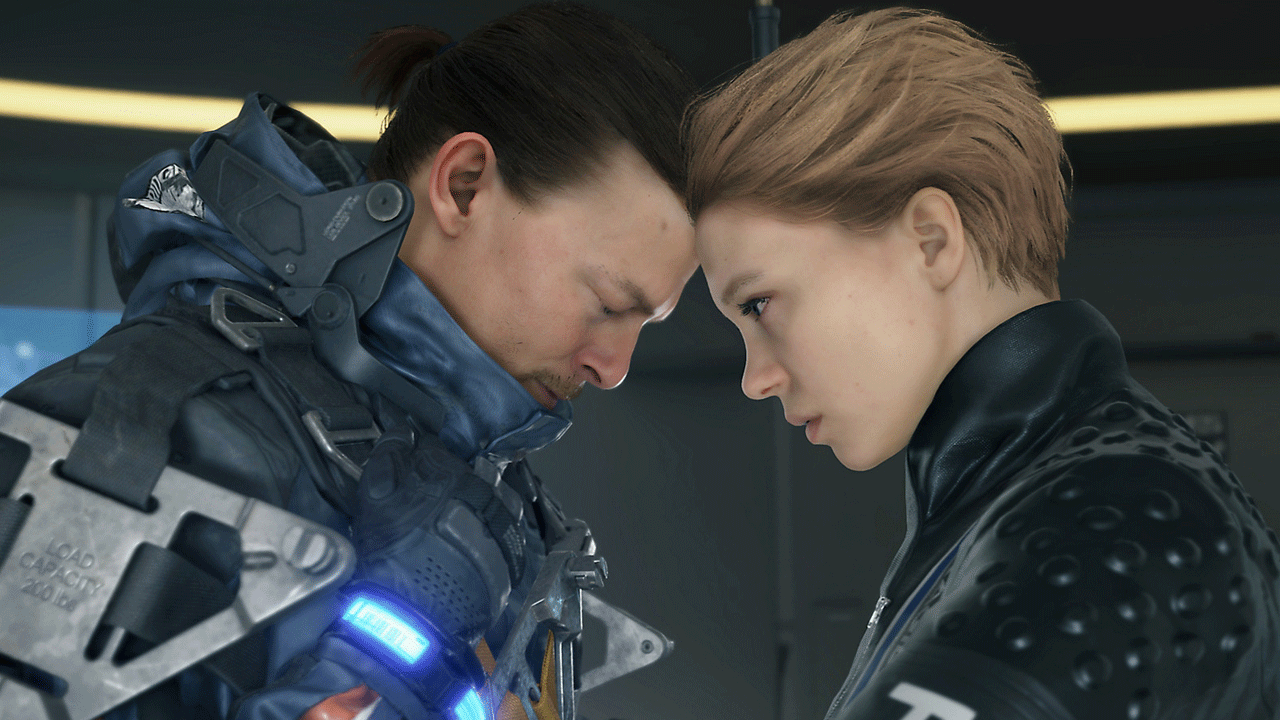
The Characters
Much like Solid Snake from the Metal Gear Solid series, the ever-stoic Sam interacts with a variety of characters who have bizarre backstories and even weirder call-signs. The members of BRIDGES, in particular, deal with all manner of strange circumstances within the Death Stranding, and as a collective, they help Sam--in their way--with making sense of the peculiar world he explores. Kojima has a well-known love of Hollywood films and TV, and that's especially noticeable in Death Stranding's cast.
Here's a quick rundown of the key players in Death Stranding:
- Norman Reedus as Sam Porter Bridges, a legendary porter now working for the government agency known as BRIDGES.
- Mads Mikkelsen as Cliff, a spectre from the past who controls an army of the dead.
- Troy Baker as Higgs, leader of the Homo Demens separatist group.
- Léa Seydoux as Fragile, company executive for Fragile Express.
- Tommie Earl Jenkins as Die-Hardman, the commander of BRIDGES.
- Guillermo Del Toro / Jesse Corti (voice) as Deadman, a BRIDGES scientist with extensive knowledge on Bridge Babies.
- Margaret Qualley as Mama, a BRIDGES scientist with a connection to the BTs.
- Nicholas Winding Refn / Darren Jacobs (voice) as Heartman, another BRIDGES scientist who repeatedly lives for 21-minutes before temporarily returning to the beach in the death realm.
- Lindsay Wagner / Emily O'Brien (voice) as Amelie, the daughter of the former UCA President. She began the westward expedition that Sam must finish.
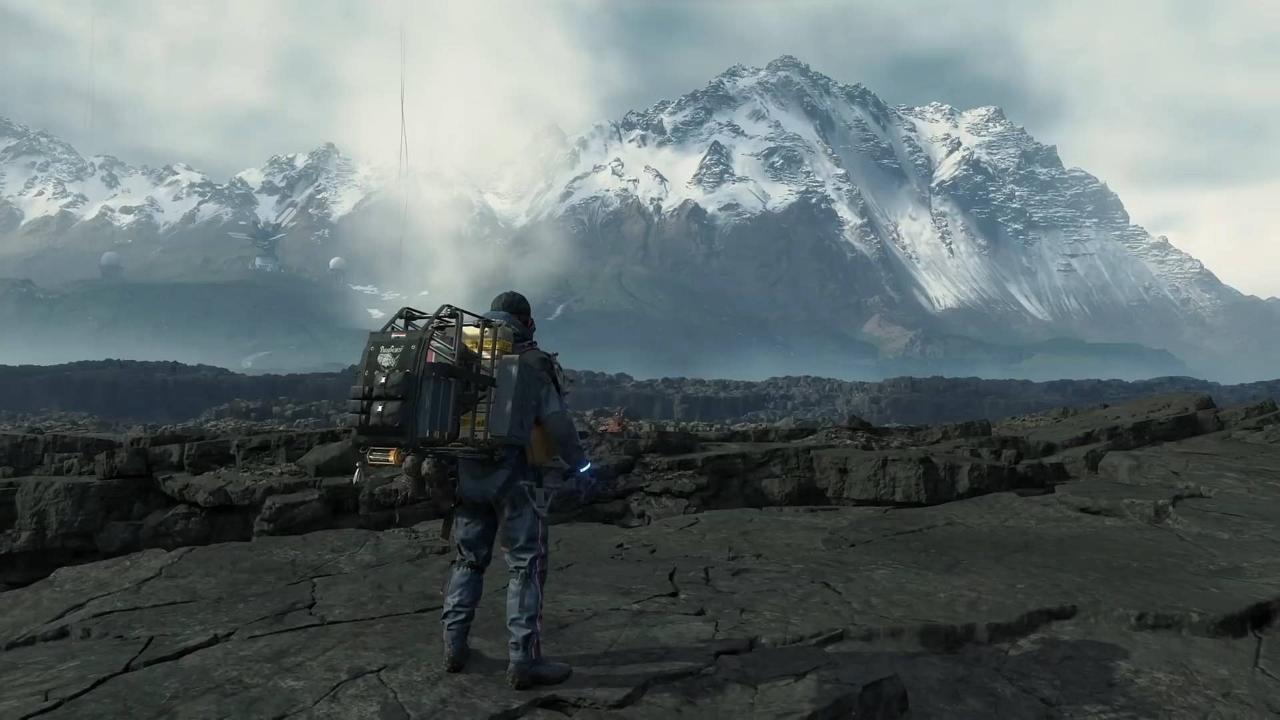
Into The Wild
When looking at Death Stranding in action, it's hard not to think back to Kojima's previous work on Metal Gear Solid V: The Phantom Pain. However, it leans less on stealth-action and more on survival-action. To outfit himself with the necessary supplies, such as a so-called Bridge Baby (the infant in the capsule attached to his suit), a power-loader suit to boost his strength, and weapons--Sam's inventory will have to be used effectively while out in the wild. Sam also has access to gear that can help him cross rough terrain. These include extendable ladders and climbing equipment, and traversal options like a motorcycle and a floating cargo carrier, which also works as a hoverboard.
The survival element encompasses a variety of different factors such as inventory management, tracking Sam's health and stamina, and even crafting equipment. Eventually, you acquire an exoskeleton, which allows Sam to carry large amounts of cargo--almost to comical levels. While you can carry a lot, you'll need to be mindful of how many boxes he has stacked onto his back, and if they're balanced evenly. If you have too many items that are stacked improperly, you can topple over when traversing. His gear can whittle down after extensive use, particularly his boots, which will break down and affect his movement speed and stamina.
To ease this danger, you can find various materials and supplies in the wild, which can net you crafting parts to create new items. But if you want to take a breather, you can also rest up while out in the field, restoring Sam's stamina and the BB's sense of calm, while also saving his progress. When push comes to shove, Sam is a resourceful guy who can make some clever use of things that you wouldn't expect. For various plot-related reasons, Sam's bodily fluids have some interesting properties to them, which can be put to surprising use out in the field. For instance, Sam's blood, urine, and feces can be repurposed into bio-weapons against BTs. When they get hit with Sam's fluids, they'll flee from the point of contact.
"I know not everyone shares our vision for the future. If we Americans don't come together again, humanity won't survive." – Amelie
Growing Influence
Sam's mission to rebuild America hinges on his capacity to help others. By completing requests from the various Preppers, you gain a set of rewards and additional social influence for Sam. Similar to your presence on social media, the more likes you get, the more pronounced your footprint in-game will be. As you get more likes, your reputation as a porter will increase, leading to unlockable upgrades for Sam--such as increased carry capacity and a stronger sense of balance. You can, however, garner fewer likes if you turn in damaged cargo. In addition to earning kudos, some of the characters can give Sam unique items. In one of the early episodes, Sam can meet a musician who will provide him with a harmonica after completing various missions. When playing the instrument at a rest point, Sam will earn extra likes.
While the expedition to rebuild the nation can be a lonely one, you won't be alone on your mission. Death Stranding connects players in style similar to Dark Souls' asynchronous online infrastructure, where players can leave messages for others while exploring. You never actually see another player in the world, but when you're online, the presence of others comes in the form of new structures and likes given to your creations. In Death Stranding, every player is in it together, and you'll have to work together to rebuild the nation's infrastructure and deliver some tough cargo. If you have a special delivery that seems too daunting, you can send it over to another player online to complete in your stead.
In addition to leaving the occasional note or giving other players a positive affirmation, you can even build constructs for others to use--such as shelters or rampways extending over rivers. However, Timefall will eventually erode player-made creations. While this will take some time, you can take part in the occasional upkeep to ensure that every resource and structure in the world is in tip-top shape. One of the larger structures to build in the world are roads, which will require a team effort. But when everyone pulls together, you can create a pathway across some treacherous landscape, bypassing BTs and other dangerous.
Kingdom Come: Deliverance 2 - Official Cinematic Announcement Trailer Stellar Blade - BIBI ‘Eve’ Official Music Video Trailer | PS5 Apex Legends: Urban Assault Collection Event Trailer Total War: WARHAMMER III - Elspeth von Draken Gameplay Showcase Genshin Impact - "Arlecchino: Sleep in Peace" | Official Character Teaser Potionomics: Masterwork Edition - Official Announcement Trailer Snowbreak: Containment Zone - "Gradient of Souls" Version Trailer Harold Halibut GameSpot Video Review Nancy Drew: Mystery of the Seven Keys | World Premiere Official Trailer Modern Warfare III & Warzone - Official Cheech & Chong Bundle Gameplay Trailer SteamWorld Heist II – Official Reveal Gameplay Trailer Dead Island 2 – Official SoLA Expansion Gameplay Launch Trailer
Please enter your date of birth to view this video
By clicking 'enter', you agree to GameSpot's
Terms of Use and Privacy Policy
The Road Warrior
One of the more common enemies you'll face are humans that roam the land or have set up base camp. According to Death Stranding lore, these roaming bandits are known as MULEs, and they're former deliverymen who became addicted to the thrill of theft in the isolated world. Following the Death Stranding event, the levels of Chirilium in the atmosphere cause significant damage to planes and drones, forcing the return to ground-based delivery. As machines are highly susceptible to Timefall and the outside elements, automation in the modern world has been dial back, prompting the return of manual labor--hence, the rise of porters.
While you can avoid MULEs, you'll sometimes need to defend yourself. Sam can use close-ranged attacks powered by his exo-suit, but he can also use his cargo as weaponized objects. However, using these objects as a weapon can damage them, putting a potential Strand at risk if you fail to deliver it intact. Sam also uses several firearms that come in lethal and non-lethal varieties. In addition to pistols and machine-guns, he can also use a non-lethal bola gun to trap enemies in an electrified wire.
Any fight, whether they're with humans or BTs, can be a bit of a challenge for Sam, especially if he's packing a lot of gear. Wear and tear with your equipment is bound to happen, and sometimes, the best course of action is to bail. If Sam doesn't have access to his motorcycle or truck, he can steal enemy vehicles to escape from enemies. However, if there aren't any vehicles, Sam's own two feet--and his exo-suit--are more than enough to get out of dodge. With your suit working at peak power, Sam's running and jumping power become significantly enhanced. This exo-suit allows him to leap great distances and run at high speeds. It can come in handy when fighting against roaming packs of insurgents, but they can mean all the difference between life and death when facing off against BTs.
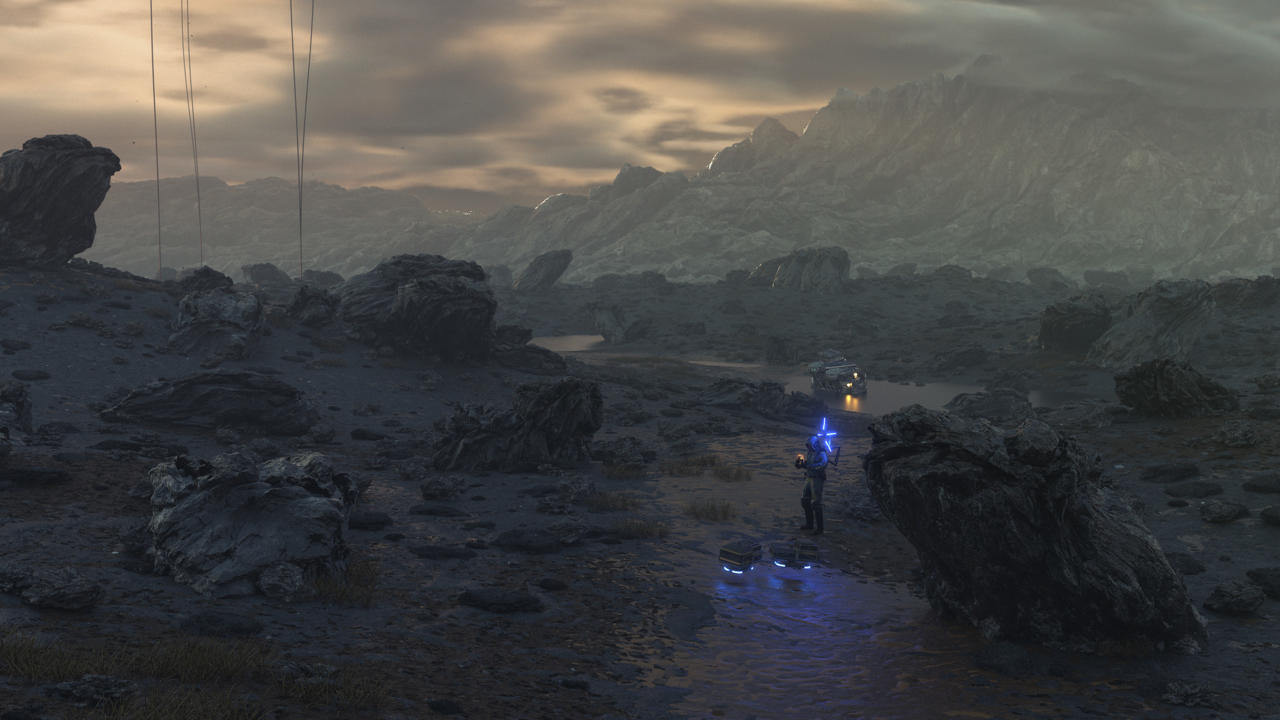
The Beached Things
Following the cataclysmic event, entities known as Beached Things (often called BTs) have become a common threat. Taking the appearance of humans or large wild creatures, they're incredibly hostile to the living, and they'll immediately go after them if they know they're there. When you pass over to the other side, you enter what is called a Beach, which is something like an afterlife. The only thing is sight is an ominous beach staring out into the void. The one thing that can help Sam against the BT threat is his constant companion in the daunting task to rebuild America--a Bridge Baby. In the early episodes, Deadman explains that the BB is a living tool birthed from the womb of "still-mothers," once pregnant women who are in a catatonic state due to the arrival of BTs. Their newborn children perceive both the living and dead realms, which is an invaluable asset for the members of BRIDGES. However, they don't have a long life expectancy. Sam's BB is nestled on his torso, similar to a front-mounted baby carrier.
When Sam encounters nearby BTs, his BB--which is plugged into his suit's Odradek (a shoulder-mounted robot)--will alert him of nearby threats. In many cases, Sam can carefully avoid contact by slowly maneuvering around them and the afflicted landscape. The BTs that Sam encounters are often known as Gazers, who appear as floating dark ghosts that loom over the field, connected to the realm of the dead by their strands. Getting too close will alert them of your presence. Once that happens, footprints will appear in the afflicted land as they approach Sam. If you're unable to escape, then Sam will be dragged down into the toxic BT substance, pulling them toward a larger BT. When this happens, you'll enter a mini-boss fight against the larger fiend. While you can fight it out, early on, you're better running away. Escaping the afflicted BT zone will cause the beast to flee. However, you're brave enough to face it, and you've got the gear to do it, then you'll be able to collect its dropped Chyrilliam crystals and clear the land of BTs for some time.
"My body may be present, but my soul is on the beach. I'm already dead." -- Heartman
Death Stranding has a very loose concept of life and death, and this also carries into the game's respawning mechanic. Sam is unlike other people, as he's known as a 'repatriate,' allowing him to defy death and return to the world of the living. After his 'death,' Sam will enter the Seam, a pit-stop between the worlds of the living and the dead. When in the Seam, you'll have control of Sam's soul as you guide it back to his mortal body. Along the way, you can also pick up whatever cargo you may have dropped before Sam's death. Once you've made the connection, Sam will return to the living world. A respawn can spur some losses, such as deliverables and some of your gear. However, it's not possible to permanently lose an item.
Downtime
If you want to take a break or unwind, you can travel to Sam's private room or a player-made safe house. In these areas, you can observe your current progress and check on your selection of equipment. You can even customize Sam's appearance, his backpack loadout, and also decorate his room. There's a surprising amount of options in how you can manipulate the room and let Sam unwind. You don't actually have control of Sam in the private place, but rather, you control the camera and direct where Sam should go. In addition to letting him pose for pictures with a variety of different hats and sunglasses, Sam can also chug some Monster Energy drinks and listen to his selection of music. Staying in a safe house also presents an excellent time to let him shower up and relieve himself in the bathroom--where the excreted fluids will be recycled into weapons.
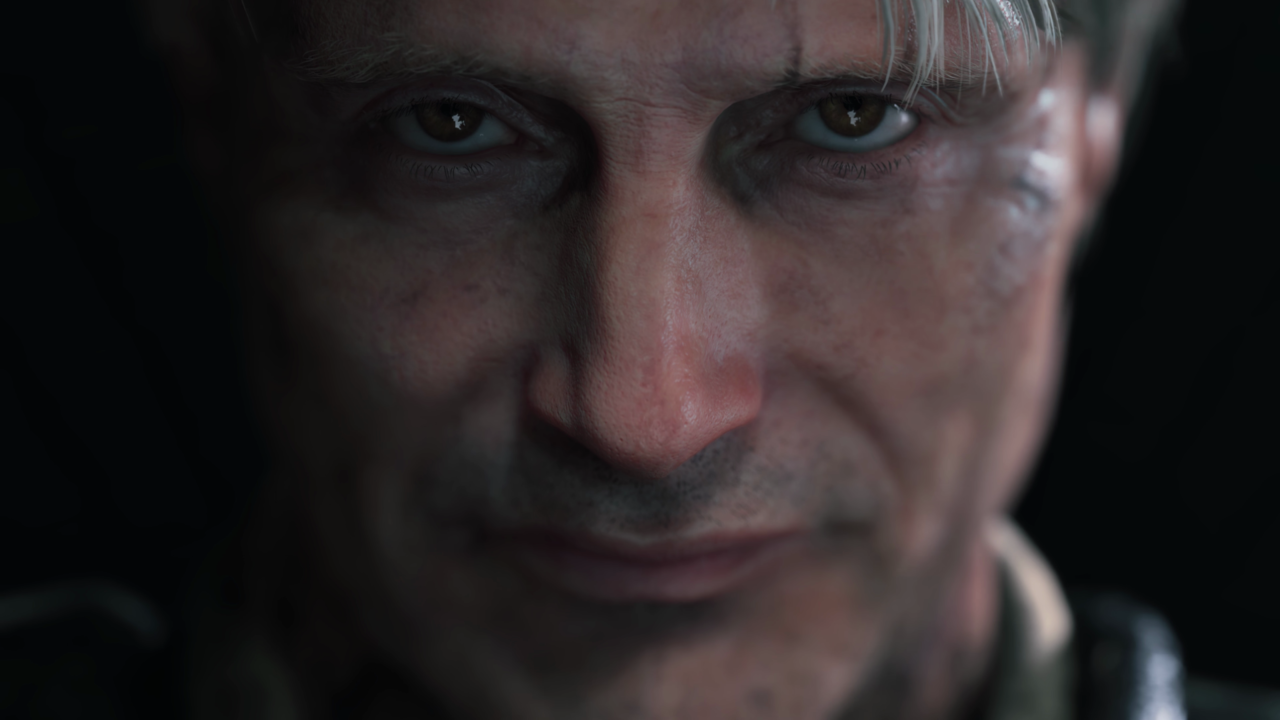
Beyond Death Stranding
The lead up to Death Stranding has inspired a great deal of discussion online about the nature of what the so-called Strand gameplay is all about. In our recent interview with Hideo Kojima, the game director will rely a lot on player trust when exploring the land, which can lead to situations where you'll have to put questions what's in front of you, and likely put faith in complete strangers online. So far, Kojima is optimistic that players will be honest in how they play the game, and how they'll communicate with others.
"We do a lot of playtests in the office. So sometimes there's a bridge that crosses a deep river, and people feel grateful, but it only goes to the middle of the river. Of course, you don't give that bridge a thumbs up, but it probably wasn't intentional. I pretty much feel that there won't be much intentional evil. I want people to think about that as well if they fall [off that bridge]..."I won't do that to someone." And you might make the same mistake."
Kojima stated that he wants to continue exploring this style of gameplay, which tasks players to connect with various aspects of the game world, and with a community of players themselves. The biggest takeaway from his work on the open-world game is the Social Strand system, which he hopes to evolve further in the years ahead. Whether he wants to continue pursuing this style himself with a direct sequel, or another game entirely remains to be seen. However, the game director has certainly prepared a game that features a dense amount of experiences therein to unpack, which will no doubt have people talking.
GameSpot's Full Review
If you want to know more about GameSpot's impressions of Death Stranding, check out the full review written by editor Kallie Plagge. In the full review, she elaborates on many of the game's more complex mechanics, and how it all manages to come together in the end--leading to a satisfying and poignant conclusion.
"Death Stranding is a hard game to absorb. There are many intertwining threads to its plot, and silly names, corny moments, and heavy exposition belie an otherwise very simple message. That comes through much more clearly in the game's more mundane moments, when you find a desperately-needed ladder left behind by another player or receive a letter from an NPC thanking you for your efforts. It's positive without ignoring pain; in fact, it argues in both its story and its gameplay that adversity itself is what makes things worth doing and life worth living. It's a game that requires patience, compassion, and love, and it's also one we really need right now."
Death Stranding Guides
- How To Get Death Stranding's Half-Life Crossover Items
- Death Stranding PC Hands-On: The Once PS4 Exclusive Runs Like A Dream
- Death Stranding Walkthrough, Guides, And Tips
- + Show More Death Stranding Guides Links (2)
- How Long Is Death Stranding?
- Can Your PC Run Death Stranding? Minimum And Recommended Specs

